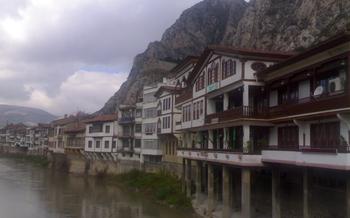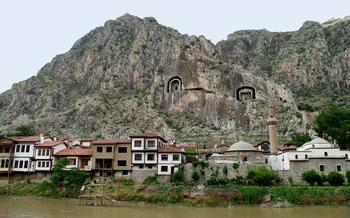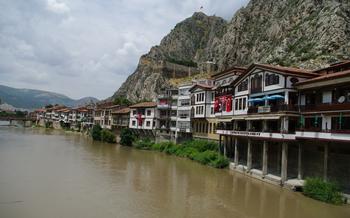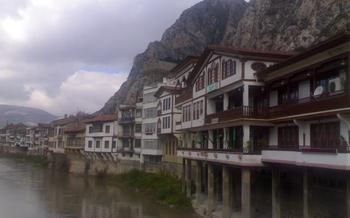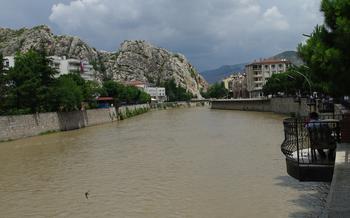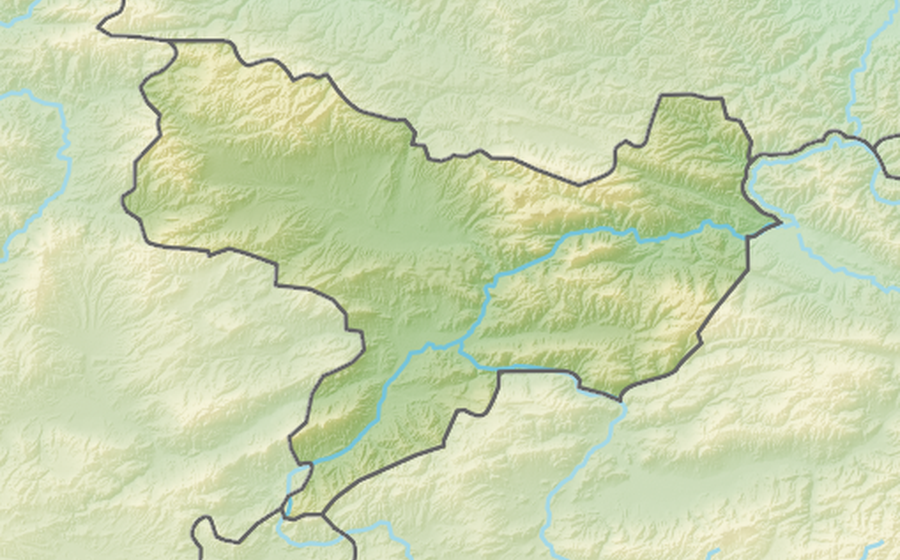
Amasya Sulu Cave
- Amasya Sulu Cave: A Unique Natural Wonder
- Exploring the Cave's Interior
- Witnessing the Underground River
- Unraveling the Cave's History
- Exploring the Cave's Ecosystem
- Tips for Planning Your Visit
- Navigating the Cave's Challenges
- Unforgettable Photo Opportunities
- Local Cuisine and Dining Options
- Additional Nearby Attractions
- Respecting the Cave's Environment
- Exploring Other Caves in Turkey
- Historical Context of Cave Exploration
- Solo Exploration vs. Guided Tours
- Insider Tip: Hidden Chamber Discovery
Amasya Sulu Cave: A Unique Natural Wonder
Amasya, a city known for its rich history and natural beauty, is home to a hidden gem that will captivate the hearts of nature enthusiasts and adventure seekers alike: the Amasya Sulu Cave. This extraordinary natural wonder is a testament to the power of nature's artistry, boasting a captivating blend of geological formations, archaeological discoveries, and local legends that will leave you in awe.
Historical Background and Significance
The Amasya Sulu Cave has been a site of human activity for millennia, with evidence suggesting that it was occupied by early civilizations as a place of shelter and refuge. Local folklore and legends attribute mystical powers to the cave, claiming that it was once inhabited by fairies and الجن (jinn), mythical creatures in Islamic mythology. These tales have been passed down through generations, adding to the cave's allure and mystery.
Geological Formations and Unique Features
The cave's geological formations are a sight to behold, showcasing the intricate handiwork of nature over millions of years. Stalactites and stalagmites of various shapes and sizes adorn the cave's chambers, creating a mesmerizing display of natural sculptures. Cave crystals, rare and precious formations, can also be found within the cave, adding to its geological significance.
Archaeological Discoveries and Artifacts
Archaeological excavations conducted within the cave have unearthed valuable artifacts and remnants of human habitation, shedding light on the cave's rich history. Ancient tools, pottery fragments, and inscriptions have been found, providing clues to the lives of those who once sought shelter within its walls. These discoveries have helped researchers piece together the story of the cave's past inhabitants and their connection to this extraordinary natural wonder.
Exploring the Cave's Interior
Stepping through the cave's entrance, you'll find yourself in a world of awe-inspiring natural formations. The initial chambers are vast and open, with towering walls adorned with intricate patterns and textures. As you venture further, you'll encounter a mesmerizing array of stalactites and stalagmites, each one a testament to the patient work of water and minerals over millennia. These formations take on various shapes and sizes, from delicate, needle-like structures to massive, imposing columns.
Look closely, and you'll also discover sparkling cave crystals, glittering in the dim light. These crystals, formed by the slow precipitation of minerals, add an ethereal touch to the cave's interior. Hidden passages and smaller chambers await exploration, inviting you to delve deeper into this subterranean labyrinth. Be sure to tread carefully, as the cave floor can be slippery, and uneven terrain may pose challenges. Remember, patience is key when navigating the cave's intricate pathways, and the rewards of discovery are immeasurable.
Witnessing the Underground River
Amasya Sulu Cave boasts a remarkable underground river, known locally as the "gizli su" or hidden water. This subterranean river originates from a nearby mountain and flows through the cave, adding to its allure and natural beauty. Visitors can witness the river as it meanders through the cave, creating a tranquil and serene atmosphere.
The origin of the river is shrouded in mystery, as it is believed to be connected to a vast network of underground waterways that run beneath the region. Its flow is consistent throughout the year, making it a reliable water source even during dry seasons. The river's crystal-clear waters reflect the shimmering light of the cave's walls, creating a magical and ethereal ambiance.
Along the river's course, visitors will encounter several viewing platforms and observation points that offer breathtaking vistas of the underground river. These platforms allow visitors to admire the river's gentle flow, listen to the soothing sound of the water, and marvel at the intricate rock formations that surround it.
It is important to exercise caution when exploring near the water's edge, as the rocks can be slippery and the water may be cold. Visitors are advised to wear appropriate footwear and avoid entering the water without proper safety precautions. The underground river is a testament to the cave's dynamic natural processes and a must-see attraction for anyone visiting Amasya Sulu Cave.
Unraveling the Cave's History
Archaeological excavations conducted within the Amasya Sulu Cave have yielded a wealth of discoveries, shedding light on the cave's past human habitation and usage. Evidence suggests that the cave was inhabited as early as the Neolithic period, with remnants of pottery, tools, and other artifacts found throughout the cave's chambers. These findings indicate that the cave served as a shelter and possibly even a dwelling place for ancient peoples.
Further exploration revealed ancient inscriptions and symbols etched into the cave walls, providing clues about the beliefs and practices of the inhabitants. These inscriptions, some of which are still visible today, offer a glimpse into the cultural and religious significance of the cave in ancient times.
Historical theories and interpretations of the cave's significance vary, with some suggesting that it may have been used as a place of worship or ritual, while others propose that it served as a refuge or hiding place during times of conflict. The cave's intricate network of tunnels and hidden chambers may have provided a strategic advantage for those seeking shelter or concealment.
By piecing together the archaeological evidence and historical accounts, researchers continue to unravel the fascinating story of the Amasya Sulu Cave, providing valuable insights into the lives and customs of past civilizations.
Exploring the Cave's Ecosystem
The Amasya Sulu Cave is home to a diverse and unique ecosystem adapted to the cave's unique conditions. This ecosystem includes a variety of flora and fauna, including specialized species that have evolved to thrive in the dark, humid environment.
One of the most fascinating aspects of the cave's ecosystem is the presence of glowworms, also known as bioluminescent insects. These tiny creatures emit a soft, blue-green light, creating a magical and ethereal atmosphere within the cave. Their bioluminescence is a defense mechanism against predators and a way to attract mates.
The cave's ecosystem also includes a variety of bats, which play a crucial role in maintaining the cave's ecological balance. These bats feed on insects, helping to control their populations, and their guano provides nutrients for the cave's plants and fungi.
The Amasya Sulu Cave is a living laboratory for studying the unique adaptations of organisms to cave environments. Scientists and researchers are working to understand how these organisms have evolved to survive in the darkness, the lack of sunlight, and the constant humidity of the cave.
Conservation efforts are underway to protect the cave's delicate ecosystem. Visitors are encouraged to respect the cave's environment by avoiding disturbing the wildlife, not touching or damaging the cave formations, and properly disposing of waste. By working together, we can ensure that the Amasya Sulu Cave remains a thriving ecosystem for generations to come.
Tips for Planning Your Visit
Plan Your Visit During Optimal Conditions: Amasya Sulu Cave is accessible year-round, but the best time to visit is during the spring or fall when the weather is mild. In the summer, the cave can become quite humid and crowded, while in the winter, some areas may be inaccessible due to ice or snow.
Allocate Sufficient Time for Exploration: To fully appreciate the cave's wonders, allocate at least two to three hours for your visit. This will give you enough time to explore the main chambers, marvel at the underground river, and take in the unique cave formations.
Pack Essential Gear: For a safe and enjoyable visit, bring comfortable clothing, sturdy footwear with good traction, and a warm layer in case the cave temperature drops. A flashlight or headlamp is a must-have to navigate the cave's darker areas. Consider bringing a camera to capture the cave's stunning beauty.
Consider Guided Tours for a Deeper Experience: Guided tours are available for visitors who want to learn more about the cave's history, geology, and ecosystem. Tours typically last around an hour and are led by experienced guides who can provide insights and point out hidden features that you might miss on your own.
Navigating the Cave's Challenges
Exploring the Amasya Sulu Cave presents various challenges that require careful navigation and proper preparation. One common obstacle is slippery surfaces due to the constant moisture within the cave. To ensure safety, visitors should wear appropriate footwear with good traction, such as hiking boots or sturdy shoes.
Narrow passages and uneven terrain are also common challenges in the cave. It is essential to be prepared for tight squeezes and uneven surfaces. Visitors should move slowly and carefully, using flashlights or headlamps to illuminate the path ahead.
Bats are common inhabitants of caves, and encountering them during your exploration is possible. While bats are generally harmless, it is essential to remain calm and avoid disturbing them. Never attempt to touch or handle bats, as they may carry diseases.
Getting lost or disoriented in the cave is a potential risk, especially in larger cave systems. To avoid this, visitors should stay on designated paths and avoid venturing into unexplored areas. It is also advisable to bring a map or GPS device for navigation and to inform someone about your planned route and expected return time.
Unforgettable Photo Opportunities
The Amasya Sulu Cave presents a photographer's paradise with its captivating subterranean world. To capture the cave's essence, photographers should seek out spots that showcase its unique formations, such as the majestic stalactites and stalagmites. Experiment with different angles and perspectives to create dynamic compositions.
Adjusting camera settings is crucial to combat the cave's low-light conditions. Use a tripod for stability, employ a wide aperture to let in more light, and experiment with shutter speed to capture the movement of water droplets or reflections. Slow shutter speeds can create ethereal effects, while faster speeds can freeze the water's flow.
Beyond the grand formations, photographers can uncover hidden details that add depth and intrigue to their shots. Look for patterns in the cave's walls, capture the play of light and shadow, or focus on the intricate textures of the cave's surfaces. Remember, respecting the cave's environment is paramount. Avoid using flash photography, which can disturb the cave's delicate ecosystem and damage fragile formations. Instead, embrace the cave's natural darkness and use it to your advantage to create evocative and atmospheric images.
Local Cuisine and Dining Options
A visit to Amasya offers a delightful culinary journey, where traditional Turkish flavors blend harmoniously with regional specialties. Before or after exploring the Amasya Sulu Cave, indulge in the local gastronomy to complete your immersive experience.
- Traditional Dishes:
- Savor the mouthwatering Amasya Çöreği, a sweet pastry filled with walnuts and honey, a local delicacy not to be missed.
-
Amasya Elması, a tender and juicy apple variety unique to the region, is a must-try for fruit enthusiasts.
-
Recommended Restaurants:
- Cimil Restaurant: Offering panoramic views of the city, Cimil Restaurant serves authentic Turkish cuisine in a charming ambiance.
-
Hasbahçe Restaurant: Located near the cave, Hasbahçe Restaurant provides a cozy atmosphere and a menu featuring local specialties.
-
Picnics and Packed Lunches:
- Pack a delightful picnic lunch to enjoy amidst the picturesque landscapes surrounding the cave.
-
Fresh produce, snacks, and beverages can be purchased from local markets and shops in Amasya.
-
Local Markets and Shops:
- Immerse yourself in the vibrant local markets, where you can find an array of fresh fruits, vegetables, and traditional Turkish delights.
- Discover hidden culinary gems at specialty shops, where you can purchase local honey, jams, and other delicacies as souvenirs.
Additional Nearby Attractions
Your journey to Amasya offers an array of cultural and natural treasures beyond the Amasya Sulu Cave. Dive into the city's rich history at the Amasya Museum, showcasing artifacts that narrate the region's captivating past. Admire the architectural splendor of the Great Mosque, adorned with intricate tilework and a testament to the city's Islamic heritage. Stroll along the picturesque Yeşilırmak River, where you can soak in the serene views and embrace the tranquil atmosphere.
Venture to Harşena Castle, perched atop a hill overlooking the city, and be captivated by its stunning panoramic vistas. Explore the ancient ruins of the Amasya Castle, a symbol of the city's resilience throughout the ages. Discover the hidden gems of the many art galleries and workshops, where local artisans showcase their exquisite craftsmanship in ceramics, textiles, and jewelry. Indulge in the flavors of Amasya's culinary scene, savoring traditional dishes like keşkek, a hearty wheat and meat stew, and tasting the region's renowned apples, a symbol of its fertile lands.
For nature enthusiasts, the surrounding area offers a delightful array of experiences. Embark on a scenic hike through the lush forests of the Yalıboyu Nature Park, where you can encounter a diverse array of flora and fauna. Marvel at the cascading waters of the Kapıçam Waterfall, a breathtaking natural wonder that will leave you in awe. Discover the tranquil beauty of the Göynücek Lake, where you can unwind amidst serene landscapes and enjoy recreational activities like fishing and boating.
Plan a comprehensive itinerary that allows you to delve into the cultural heritage, natural wonders, and culinary delights of Amasya. Immerse yourself in the city's vibrant atmosphere, embrace the warmth of its people, and create unforgettable memories that will last a lifetime.
Respecting the Cave's Environment
As visitors to the Amasya Sulu Cave, it is crucial to uphold responsible behavior to protect and preserve its delicate environment. Here are some guidelines to follow:
-
Avoid Touching or Damaging Formations: Refrain from touching or climbing on the cave's formations. The oils from our hands can damage the delicate surfaces and hinder their growth.
-
Proper Waste Disposal: Carry all trash and waste out of the cave. Littering and leaving behind trash not only detract from the cave's beauty but also harm its ecosystem.
-
Minimize Environmental Impact: Minimize your impact on the cave's environment by avoiding loud noises, using flash photography, or disturbing the wildlife. Respect the tranquility of the cave and allow others to enjoy its natural beauty.
-
Educate Others: Share your knowledge about the importance of cave conservation with others. Encourage fellow visitors to respect and protect the cave's environment. By working together, we can ensure that future generations can also marvel at the wonders of the Amasya Sulu Cave.
Exploring Other Caves in Turkey
Turkey is home to a wealth of caves, each with its own unique features and attractions. If you're captivated by the wonders of Amasya Sulu Cave, you'll be delighted to know that there are many other incredible caves waiting to be explored throughout the country.
One notable cave is the Karain Cave in Antalya, which boasts a rich history dating back to prehistoric times. With its ancient cave paintings and archaeological findings, Karain Cave offers a fascinating glimpse into human habitation and artistic expression in the region.
Another must-see cave is the Dim Cave in Alanya, known for its stunning underground lake. This crystal-clear lake reflects the cave's majestic formations, creating a truly breathtaking sight. Take a boat ride on the lake for an unforgettable experience.
For those seeking adventure, the Ilgarini Cave in Mersin is a challenging yet rewarding destination. With its narrow passages, vertical drops, and stunning rock formations, this cave is perfect for experienced cavers looking for a thrilling exploration.
If you're interested in a cave with a unique ecosystem, head to the Ballıca Cave in Isparta. This cave is home to a colony of blind cave salamanders, a rare and fascinating species that has adapted to the darkness of the cave environment.
Plan a trip to explore these and other caves in Turkey to discover the country's hidden wonders. Each cave offers a unique experience, so you're sure to find one that suits your interests and adventure level.
Historical Context of Cave Exploration
Cave exploration, also known as speleology, has a rich and fascinating history that spans centuries. In the early days, cave exploration was primarily driven by curiosity and a thirst for adventure. Over time, it evolved into a scientific discipline, with explorers seeking to understand the geological, biological, and archaeological significance of caves.
One of the most famous historical cave explorers was Édouard-Alfred Martel, a French speleologist who is considered the father of modern cave exploration. In the late 19th century, Martel conducted extensive explorations in caves throughout Europe, developing techniques and equipment that are still used today. He also made significant discoveries, including the vast cave system beneath the Pyrenees Mountains.
In the 20th century, cave exploration became more accessible due to advances in technology, such as electric lighting and SCUBA diving equipment. This led to the discovery of many new caves and the exploration of deeper and more complex cave systems. Today, cave exploration is a global pursuit, with cavers from all over the world exploring caves for scientific, recreational, and conservation purposes.
Caves have played a crucial role in understanding Earth's geological history. By studying the formations and deposits found in caves, scientists can learn about past climates, geological processes, and the evolution of life on Earth. Caves have also been a source of archaeological discoveries, providing evidence of human habitation and cultural practices from ancient times.
In recent years, there has been a growing emphasis on cave conservation. Many caves are fragile ecosystems that are easily damaged by human activity. Cavers are working to protect caves by promoting responsible exploration practices, conducting scientific research, and educating the public about the importance of caves.
Solo Exploration vs. Guided Tours
Whether to embark on a solo exploration or join a guided tour when visiting Amasya Sulu Cave is a personal choice that depends on your preferences and comfort level. Each option offers unique advantages and considerations.
Solo Exploration:
- Pros:
- Freedom and flexibility to explore at your own pace and choose your path.
- Opportunity for a more intimate and personal experience with the cave.
- Potential for making your own discoveries and experiencing a sense of adventure.
- Cons:
- Requires more planning, preparation, and knowledge of cave safety and navigation.
- Can be more challenging to find hidden passages or formations without a guide.
- May miss out on valuable insights and information provided by experienced guides.
Guided Tours:
- Pros:
- Provides a safe and informative experience with knowledgeable guides.
- Guides can lead you to specific formations and hidden chambers, ensuring you don't miss any highlights.
- Offers a deeper understanding of the cave's history, geology, and ecosystem.
- Cons:
- Less flexibility and spontaneity, as you must follow the group's pace and itinerary.
- May be more expensive than solo exploration.
- Can be crowded, especially during peak tourist season.
Ultimately, the best choice depends on your comfort level, budget, and desired experience. If you're an experienced caver or prefer the thrill of exploring independently, solo exploration might be a good option. However, if you're new to cave exploration or want to learn more about the cave's history and significance, a guided tour is highly recommended.
Insider Tip: Hidden Chamber Discovery
During my initial exploration of the Amasya Sulu Cave, I stumbled upon a hidden chamber that was not marked on any map or guidebook. As I ventured deeper into the cave, squeezing through narrow passages and scrambling over rocks, I noticed a small opening concealed by a curtain of stalactites. Curiosity piqued, I ducked under the stalactites to find myself in a breathtaking chamber adorned with sparkling cave crystals. The chamber's walls were covered in intricate and colorful formations that seemed to glow in the dim light of my headlamp. It was a moment of awe and wonder, as if I had discovered a secret treasure hidden within the depths of the cave.
Since then, I have shared the location of the hidden chamber with a select few fellow explorers who have shown a genuine appreciation for the cave's delicate ecosystem. It remains a special place that I cherish, and I encourage adventurous visitors to seek out its hidden beauty while respecting the cave's environment.

